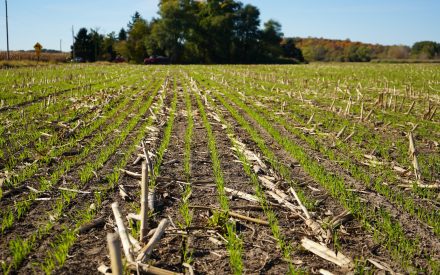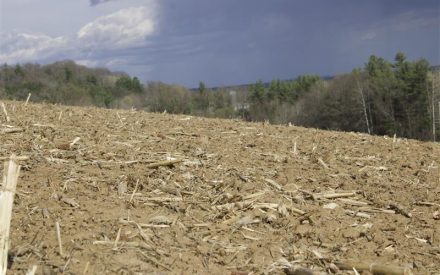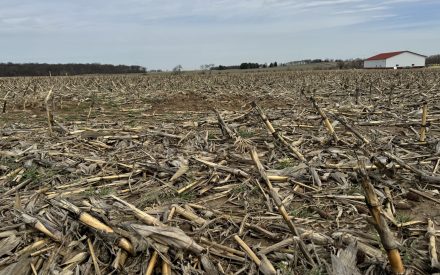This article was originally published in the Journal of Nutrient Management
Historically, reduced tillage, defined here as tillage that maintains plant surface residue and where nutrients are surface applied (i.e. no-till, zone, strip, or vertical tillage), were touted as the solution for phosphorus loss from agricultural fields. This article elevates the issue of phosphorus loss without erosion by highlighting dissolved phosphorus loss pathways. Reduced tillage decreases phosphorus loss risk by two main processes, by decreasing soil erosion and increasing soil’s infiltration capacity.
Keeping more topsoil in the field has many agronomic and water quality benefits by keeping valuable soil-bound phosphorus nutrients in the field and soil out of surface waters. Reduced tillage leaves a protective residue on the surface, physically protecting the soil by intercepting powerful raindrops from hitting the surface and dislodging soil, which is then more susceptible to erosion. Wisconsin’s Discovery Farms edge-of-field monitoring shows that around 50% of the total phosphorus that leaves fields in Wisconsin is typically in this particulate form and is commonly lost in late spring and early summer when heavy precipitation is paired with no canopy cover and unfrozen ground (Figure 1).
Second and less discussed, is reduced tillage’s ability to increase soil’s water infiltration capacity. The decrease in disturbance allows for increased organic matter protection, and worm and microbial activity which helps to increase soil aggregate stability and create channels where water can infiltrate. When the ground is unfrozen, fields that infiltrate more water effectively reduce the amount of water running off the field into surface water bodies. Less surface water leaving the field typically means less particulate and dissolved phosphorus loss. The smaller volumes of water can carry less soil, and can interact with less sources of water soluble phosphorus.
Reduced tillage can have tradeoffs, the previously mentioned benefits mostly reduce phosphorus loss on unfrozen ground, which is typically when only 50% of the phosphorus loss occurs in Wisconsin. Recent research and monitoring have shown that reduced tillage can intensify dissolved phosphorus loss, by increasing the amount of phosphorus at the soil surface. Dissolved phosphorus loss is not dependent on soil movement. Rather, it is driven by water interacting with organic and water-soluble forms of P, like residue, synthetic fertilizer, manure, or even P attached to soil. Dissolved phosphorus is often lost in winter months when the soil is frozen, snowmelt is occurring and little infiltration can occur (Figure 1).
In reduced tillage systems there tends to be a build up of residue or plant biomass on the soil surface, all sources of phosphorus. Long-term reduced tillage fields can lead to increased phosphorus levels in the top inch or two of the soil due to broadcast applications of manure and synthetic fertilizer. This stratification of phosphorus at the soil surface creates a high risk for interaction between phosphorus sources and a large amount of runoff water via snowmelt, rain, or both.
These processes occur in Wisconsin and throughout the Upper Midwest. Twenty years of Discovery Farms monitoring has shown that annual total phosphorus loss between conventionally tilled and no-till fields is about equal. Soil loss is greatly reduced (Figure 2a and 2c) under no-till but, as discussed above, can result in increased phosphorus losses in the dissolved form (Figure 2b). In the Lake Erie watershed, where cover crops, reduced tillage and other conservation practices have been heavily adopted, dissolved phosphorus loads have doubled in the 2000’s compared to the 1990s, even though total phosphorus load have stayed relatively the same (Scavia et al., 2014; Watson et al., 2016). The benefits of reduced tillage to other soil and agronomic properties should not be overlooked. Small adjustments can be made to maintain the benefits of reduced tillage while minimizing sources of phosphorus on the surface.
Figure 2. Annual total phosphorus (a) is similar between tilled and no-till fields, due to the increase in dissolved phosphorus loss from no-till fields (b), even though soil loss (c ) is greatly reduced.
Recommended strategies to mitigate dissolved phosphorus losses
- Reduce P applications and use crop removal to draw down soil test phosphorus (STP) over time
- Soil’s ability to bind phosphorus to its surface has led to it being a major source of phosphorus rather than a sink after years of application of phosphorus greater than crop removal.
- High STP values have doubled over the last 50 years (Dodd and Mallarino, 2005). STP in the top inch of the soil is related to the amount of dissolved phosphorus loss in agricultural fields (Figure 3).
- A typical corn crop in Wisconsin only removes 3-5 ppm of P per year if no other P is applied (Laboski et al., 2006). Drawdown of STP can take awhile.




 Phosphorus Losses Checked by Layered Practices and Careful Timing: A Discovery Farms Project
Phosphorus Losses Checked by Layered Practices and Careful Timing: A Discovery Farms Project ▶ The Zone of Interaction: Exploring phosphorus stratification
▶ The Zone of Interaction: Exploring phosphorus stratification Wanted: Fields under cover
Wanted: Fields under cover Flood Mitigation and Water Quality in Southwest Wisconsin
Flood Mitigation and Water Quality in Southwest Wisconsin


